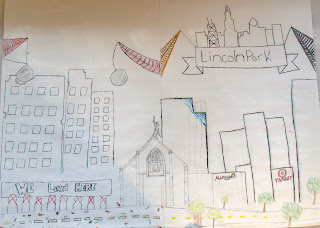Our Grosshinger Mural Proposal
On the second week we went 4 different F.E’s one every day except on Wednesday when we stayed in to watch the documentary Style wars which was about the graffiti and hip-hop culture that had heavy influence on culture in New York in the 1970’s and 1980’s. We met with various artists to continue our adventure in learning more about public art. We met with Tanner from the Design Museum, Rich from the We All Live Here movement, The Chicago public art group, and Brittany Maddock at the Media Stream. We were able to see so much art work and learn more about the process public art usually through. Rich taught us the different ways that art is able to inspire people and bring in a sense of community and unity between it’s audience. Brittany taught us that public art can also very much be digital and the work that goes behind making it come alive. The Chicago Public Art Group taught us that most often times public art isn’t often seen as valuable bye some authorities. We acquired much knowledge from talking to professionals and the F.E’s were overall filled with great experiences and we got to learn a lot about the art in our city.
Photos by: To, Hiu 2019
Our artist statement goes as follows:
This art piece is for those who aren't aware of the complex history of the Near Northsidewe as it was considered the first "bad" neighborhood in Chicago. Known as "Little Hell" during its birth, it housed Italian & german immigrants in 1820. It had multiple gang wars throughout its lifetime. As different groups such as Puerto Rican and African-American entered the community, the original members gave backlash as hard as they could. Groups slowly became neutral, and the violence cools down during WWII. After the war, the housing project was fully built, and policies were made to segregate the European and African American communities. The European descent left for the suburbs, and the "Cabrini Green" era was born. Due to such policies and the restrictive feeling of space, violence was brought back up that was last seen 80-90 years prior. Despite the hard push from the residents, the city during the 90s decided to destroy the community, pushing gentrification and building "New City." The original residents were relocated with new residents aware of the history of before.
For the project, we went around the neighborhood, taking pictures and writing responses from the residents of New City. We found out that most were oblivious to history and didn't live in the area because it was too expensive. One person considers the area not to be a community because the people living there kept to themselves. Some didn't enjoy the streets felt artificial, while others felt great about the neighborhood because of the lack of conflict. It was a contrast between ages because of the overall ignorance of the young. There was also remorse of the Cabrini Green buildings and questions on what happened to its people.This piece addresses the needs of ignorance and remorse. Not only did we show the destruction of Cabrini Green, but also the large brand stores that now sit on top of what used to be. The history of these communities includes these brands, and we decided to show them to take a "homey" feeling that could have been there in Lincon Park. Overall, we tried to address the need for education for the newcomers and remind the old comers of Cabrini. The piece is a memorial to what was Cabrini Green and how it was almost taken out of existence. We decided to use the 2D mural as it looked like a timeline and showed contrasting styles for emphasis on different parts of the piece. There are three parts of the section; Cabrini Green, the abandoned church in New City, and New City. There is more color on Lincoln park compared to the other parts, but it feels too clean and almost artificial. Cabrini Green is white, feeling set in one state of time while being demolished. The church is supposed to be the final piece of Cabrini Green as it is between two worlds. However, where the cross on the church initially was, there's a person melted within the church. Unlike all the other items in the piece, he is drawn dramatically and given an epic feeling. He has one fist up, symbolizing the pride for his community and the hand asking for charity as his village is becoming destroyed for development. The church, still staying on both worlds, is implied to be killed like the rest of Cabrini Green.




Comments
Post a Comment